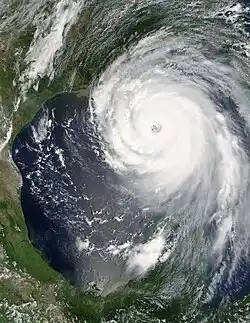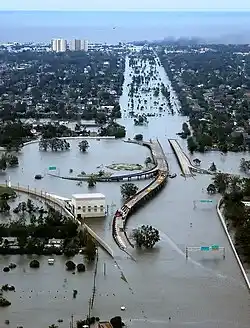
Hurricane Katrina was a Category 5 hurricane which formed on the 23rd of August 2005 and lasted just over a week. It began north of the Caribbean and took full shape as it passed on the northern side of the island of Cuba. It then passed over southern Florida and into the Gulf of Mexico before turning northwards and making landfall over Louisiana. It devastated much of the state, particularly the city of New Orleans, causing nearly 1,400 fatalities and inflicting around $125 billion dollars’ worth of damage. Katrina was the fourth strongest recorded Atlantic hurricane to ever make landfall in the United States and the third most destructive, surpassed only by the Great Galveston Hurricane of 1900 and the 1928 Okeechobee hurricane in Florida. Katrina led to a collapse in the population of New Orleans from over 480,000 people to just over 230,000, a decline which has only partly been reversed since.[1]
Research your ancestors on MyHeritage
Hurricane Katrina chronology of eventsHurricane Katrina chronology of events
Until it was eclipsed in 2020, 2005 was the most active year in recorded history for hurricanes and major storms in the Atlantic. There were 28 storms of a tropical and subtropical nature, so many that the list of names which were pre-selected to name that year’s storms was exhausted and new names had to be devised to name the storms at the end of the season, a sign of how unusually busy the hurricane season was that year. Of these, none was more destructive than Hurricane Katrina.[2]

Katrina formed on the 23rd of August 2005 north of the island of Cuba. It then moved westwards, crossing over southern Florida and into the Gulf of Mexico through the 26th and 27th of August where it intensified into a Category 5 hurricane. The storm then took an almost right-angle turn northwards and headed towards the states of Louisiana and Mississippi. As hurricanes and tropical storms do, it weakened as it made landfall very early on the 29th of August to a very strong Category 3 hurricane. Even with the decline in strength, wind speeds as high as 125 miles per hour were recorded as it made landfall and regularly peaked over 100 miles per hour in the hours that followed. The worst of the storm occurred on the 29th and into the 30th. As the 30th progressed it changed in an extra-tropical storm and it dissipated as it moved further inland on the 31st of August.[3]
Katrina caused immense destruction over Louisiana and Mississippi, particularly so in the city of New Orleans. It has been argued that much of this was man-made as the storm caused the city and wider region’s flood defense systems to fail in a state large portions of which are effectively at sea level under normal circumstances. Over three-quarters of the city of New Orleans flooded as a consequence and the failure of the flooding system of levees meant that the metropolis remained underwater for weeks to come.[4] Thousands of people were missing for weeks, though eventually it transpired that the death toll was lowered gradually to around 1,800 and eventually to just under 1,400 people. The damage to property was over $100 billion dollars as most of New Orleans was effectively destroyed. With associated damage the cost of Katrina’s impact on the US economy is understood to have been around $125 billion dollars’ worth.[5]
Extent of migration during and after Hurricane KatrinaExtent of migration during and after Hurricane Katrina
An estimated 1.5 million people were displaced in Louisiana and Mississippi as a result of Hurricane Katrina. Most did not move very far and headed into the adjoining states, Texas, Alabama, Tennessee and Arkansas. Texas was the foremost destination, with some studies estimating that 40% of those who were displaced ended up moving into the Lone Star State.[6] Within Texas, the city of Houston became the epicenter of the refugee crisis caused by Katrina. Hundreds of thousands of people ended up here and many would chose to make Houston their new home in the years that followed as New Orleans had been so devastated.[7]
Demographic impact of Hurricane KatrinaDemographic impact of Hurricane Katrina

The greatest demographic impact was felt in the city of New Orleans, large parts of which were destroyed by the hurricane as it made landfall. The Louisiana city had a population of just over 480,000 prior to the hurricane, although this varies depending on how one evaluates the extent of the urban city and wider metropolitan area. Many people fled the city as the hurricane arrived, while tens of thousands left afterwards as their homes or businesses had been destroyed. By the summer of 2006, the population was only around 230,000, less than half what it had been prior to Katrina. Six years later, in the summer of 2012, it had recovered to nearly 370,000, but it has remained around this level ever since, meaning that the city’s population is still down nearly 25% on what is was prior to the hurricane.[8]
See alsoSee also
Explore more about Hurricane KatrinaExplore more about Hurricane Katrina
- Louisiana Obituaries records collection on MyHeritage
- Introduction to the Bayou State: Louisiana for Beginners at Legacy Family Tree Webinars
- Hurricane Katrina at History
References
- ↑ https://www.nationalgeographic.com/environment/article/hurricane-katrina
- ↑ https://www.weather.gov/tae/climate_2005review_hurricanes
- ↑ https://time.com/hurricane-katrina-10-years-later/
- ↑ https://www.pbs.org/wgbh/nova/orleans/how-nf.html
- ↑ https://time.com/hurricane-katrina-10-years-later/
- ↑ https://www.ncbi.nlm.nih.gov/pmc/articles/PMC4048822/
- ↑ https://www.theguardian.com/us-news/2015/aug/25/new-orleans-west-houston-hurricane-katrina
- ↑ https://www.datacenterresearch.org/data-resources/katrina/facts-for-impact/

